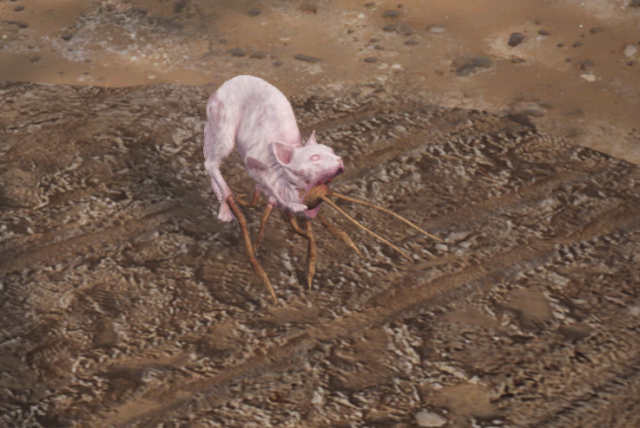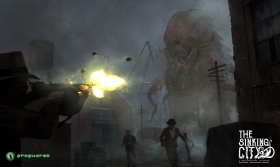
The Sinking City Review
"The most merciful thing in the world, I think, is the inability of the human mind to correlate all its contents. We live on a placid island of ignorance in the midst of black seas of infinity, and it was not meant that we should voyage far. The sciences, each straining in its own direction, have hitherto harmed us little; but some day the piecing together of dissociated knowledge will open up such terrifying vistas of reality, and of our frightful position therein, that we shall either go mad from the revelation or flee from the light into the peace and safety of a new dark age."
- H.P. Lovecraft, The Call of Cthulhu.
It's kind of traditional to quote HPL when writing up anything Lovecraftian, and this game is certainly that. The Sinking City is an investigative horror game, combining several different styles of gameplay and environments, and set in the weird and grim city of Oakmont, flooded and inhabited by similarly gruesome creatures.
In broad strokes, you play Charles Reed, an ex-Navy sailor turned Private Eye, who is beset with disturbing visions and dreams. Contacted by a mysterious gentleman he is directed to the city of Oakmont Massachusetts, which does not appear on any maps, and is cut off from the mainland by the sea and a flood that has semi-submerged the streets, leaving large areas only traversable by boat. The city has seen an influx of refugees from the nearby town of Innsmouth, which has been burnt to the ground by the government for unspecified reasons. These refugees give a disturbing feel to the now locals with their genetic heritage and distinctive "look".

Oakmont is an open world map that in part has been procedurally generated to save time during development, and uses the Unreal Engine for the core system. Once into the basics of the game you're given a hint about "hobo signs" on various buildings and objects which indicate inhabited buildings, material and ammo stashes, and buildings to avoid. Large chunks of the map are underwater, necessitating the use of a boat which is automagically present at any pier for you to take a trip in to another pier. The map is laid out with street names which are required to track down some of the locations of side quests where letters and in-game documentation list addresses by junction and so on.
Walking round the city is reminiscent of many games past. The abandoned look has hints of fallout (without the airstream tech), or even the more recent Vampyr in its Victorian London. Flashbacks of third person navigation in tight city streets brings up visions of Assassin’s Creed as well, although there's certainly not the ability to go anywhere, many arbitrary boundaries exist, leaving you unable to climb obvious ladders, or climb over what look like simple fences. This is a shame, but given the tightness of the environment, and the need to push the player into using the boat to navigate some of the areas, making it a "true" open world would probably have been impractical. NPCs litter the environment as well, and during my play glitched in and out of existence when I looked away and then back. As you play further, you realise that Charles is having disturbing visions and dreams, and therefore this may have been deliberate to encourage the spooky atmosphere, but honestly felt like glitchy NPC management to me. Interactive objects are highlighted when you get up close, although there's sometimes confusion over objects which you can examine and pick up, or only examine, which got a little frustrating when you felt it should be possible to collect the object for later reference.
Playing on the PC I'm sticking with the controller as I dislike third person games with the keyboard and mouse combination, but I do feel that the early tutorial style section could have been a little more specific about how you go about certain tasks, and for a pure console player it might get a little claggy as you start off. There is however a "how to play the game" menu section with some summaries about certain bits of the gameplay, and that helped.

At The Sinking City's heart is an investigative game, where you pull various facts gleaned from dialogue, documentation, and physical clues and assemble them by combining them in a "Mind Palace" tab of the in-game management. Locations indicate whether you've found all the evidence available, and objects can be picked up and manipulated, indicating when there's a specific detail you need to take note of. This mechanic was straight out of Team Bondi and Rockstar's L.A. Noire, and the tracking of the evidentiary material gives a new spin on Cole Phelps' notebook. I'm not knocking it though, and the ability to combine the evidence and produce summary "deductions" is useful, although essentially turns it into a trial-and-error exercise where you just jam stuff together until the game gives you something. There's not the ability to generate incoherent or incorrect conclusions which could lead you down the wrong path, or result in different investigative outcomes (that I'm aware of so far) although this would obviously be a literal dead end unless managed at a macro level to players who wanted to come up with specific outcomes, or even morally preferable ones.
There are moral decisions to be made though. In the initial investigation, you can either hand someone in, or let them off the hook, regardless of the actual outcome of the investigation, which is the same conclusion either way.
There's a unique ability for Charles, titled "Minds Eye", an alternate view of the world which picks up supernatural omens, and can direct him to hidden areas, clues etc. This also throws up semi-interactive retrocognition visions, where he can assemble some flashbacks of the past into a coherent narrative, which then drives conclusions and moves him along the investigation. Some of these visions and views can get very disturbing, and have an impact on his Sanity level, which is tracked alongside his health level in the on-screen HUD.
Lose sanity, and things get even more weird, with Charles holding his own gun to his head, and other disturbing tics and hallucinations.
Strange noises and visual distortions also indicate nasties, which are body-horror monsters tearing their faces open, or made out of more legs than a Michael Flatley show. The docks where you being the game are also inhabited by harmless creatures, the first of which I've dubbed the "CatPrawn" and regardless of anything appearing later specifying the creature in the in-game bestiary will always be CatPrawn to me.

While an investigative game, there is some combat and it allows for guns or melee attacks. There is some aim assist in the settings, but even with "strong" selected I was finding it difficult to get on target, but I was using a controller, and maybe KBM would have allowed for more accuracy. The combat difficulty setting also decides the efficacy of first aid kits.
One slight complication about gunplay is that every shot you take reduces the amount of in-game currency you have to spend: bullets. On the other hand, if you're adept at scavenging, and keep your eye out for the right hobo sign, then you can craft ammunition to top up when needed. Crafting also allows for traps, antipsychotics and first aid kits.
All of the above tie into the Skills system, with points being given at XP levels. These improve the various metrics for survival, ability to maintain sanity, investigative skills, carrying capacity and so-on. Fairly simple, and easy to manage.
I tried to like this game, but no game is flawless. There are a few glitches I've come across, such as glitching into the sea, and being unable to climb out, which results in a tentacly death. NPCs randomly appearing and disappearing, and rather un-aware rafts transporting people around the watery sections which don't seem to give a damn about you and your boat. The lack of transitions between the boat and land feel a little lazy, simply teleporting from standing on the pier to being in the boat or vice-versa which feel a little poor given how other open-world games manage this mechanic seamlessly. Given the lethal nature of ending up in the water I guess this removes the risk of falling in between the pier and the boat, but if their climbing mechanic had been more reliable this wouldn't have been as bad.
One little thing, and it is a little thing I guess, but very annoying: You have a camera, a traditional concertina folding camera. You can equip it, and point it, and take a picture. Which then disappears, never to be seen again. It’s not stored and not saved, it simply doesn't exist. If you take pictures of things which have a camera icon on them, then no problem, they get logged in your library of evidence and so on, but otherwise, it's simply pointing it at things and clicking a button pointlessly. GTA V is the only game I've encountered so far with an in-game camera where you can access the photos outside of the game. So many games have a meta "photo mode" so you can screen grab etc. It just pisses me off in a situation like this that it doesn't point out to you that there's no point snapping away at things of interest when the photos don't actually go anywhere. Little things like this are a shame when the world looks so interesting.

Given the UI for the game is pretty decent, allowing for the transition between Mind Palace, evidence logs, inventory and so on, it's a shame the in-game dialogue UI feels a little dated compared to newer games, rather large (although easier to read) and felt like it could have been refined a little more, rounding the corners of backgrounds, softening the text. Most of the dialogues follow the interview frame style, with the camera switching to look at the speaking character, much like most games in this situation.
All this said, after so many hours of play, the shortcomings come into focus more and more. The above conceit, of using bullets for currency is a red herring, not having had the need, or opportunity even to actually spend bullets. Rather wasting them due to the shocking combat, and very poor aim assist. The amount of gribblies is very inconsistent, although heavier weapons are obviously more effective.
The underwater sections are interesting, though linear, and incredibly frustrating as you can't heal during them, and I got into a loop of respawning in between two dangers, one of which didn't respond to either the speargun, or underwater flare, the only two "weapons" you have available when diving.
I so wanted to like The Sinking City and at the start i was invested in enjoying it, but after playing more and more, I just get frustrated and annoyed at the poor execution. If anyone can explain why a game which was in dev for so long comes out with so many glitches and poor code, then answers on a postcard.
A brilliant concept with some excellent ideas, let down badly by the game engine, inconsistent writing and plotting
The Sinking City (Reviewed on Windows)
Game is enjoyable, outweighing the issues there may be.
A brilliant concept with some excellent ideas, let down badly by the game engine, inconsistent writing and plotting











COMMENTS